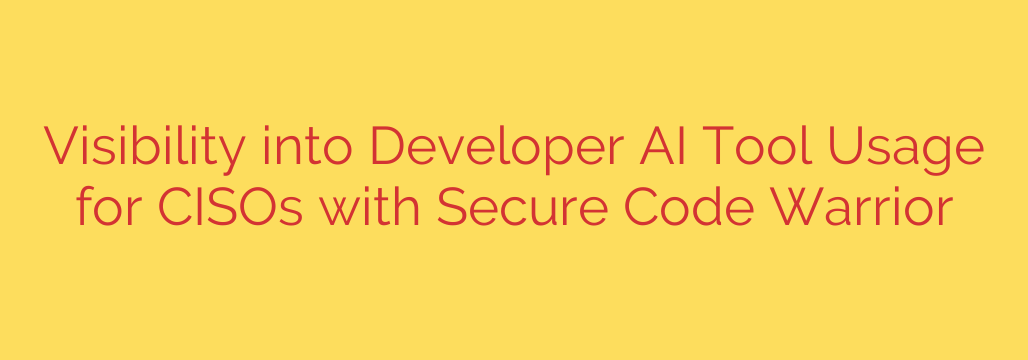
The CISO’s Blind Spot: Gaining Visibility and Control Over Developer AI Tools
Generative AI coding assistants like GitHub Copilot and ChatGPT are no longer a novelty; they are rapidly becoming standard tools in the modern developer’s workflow. The promise is undeniable: accelerated development cycles, increased productivity, and faster problem-solving. But for Chief Information Security Officers (CISOs) and security leaders, this rapid, often unsanctioned adoption creates a significant blind spot—a “shadow AI” problem that introduces new and complex risks into the Software Development Life Cycle (SDLC).
The core challenge isn’t the technology itself, but the lack of visibility. When developers independently use AI tools, security teams are left asking critical questions:
- Which developers are using AI assistants?
- Which specific tools are they using?
- How frequently are they relying on AI-generated code?
- Are they blindly accepting suggestions that may be insecure or non-compliant?
Without answers, it’s impossible to build an effective governance or security strategy. Attempting to secure the SDLC without insight into AI tool usage is like trying to secure a building without knowing how many doors and windows have been installed.
The Double-Edged Sword: Productivity vs. Hidden Security Risks
While developers embrace AI for its efficiency, security leaders must address the serious risks that come with unchecked adoption. These aren’t just theoretical concerns; they are active threats to your organization’s security posture and intellectual property.
Key risks include:
- Introduction of Insecure Code: AI models are trained on vast datasets of public code, which often includes vulnerabilities. An AI assistant can easily suggest and insert flawed or insecure code snippets, which are then baked directly into your applications.
- Data and Intellectual Property (IP) Leakage: Developers might inadvertently paste sensitive information, proprietary algorithms, or secret keys into an AI tool’s prompt to get help, potentially sending that confidential data to a third-party model for training purposes.
- Licensing and Compliance Violations: AI-generated code can be based on code with restrictive open-source licenses. Using this code without proper attribution or adherence to licensing terms can create significant legal and financial liabilities.
- Over-reliance and Skill Atrophy: A heavy dependence on AI for code generation can lead to developers accepting suggestions without fully understanding their security implications, potentially eroding critical secure coding skills over time.
Simply banning these powerful tools is not a viable long-term solution. Doing so risks creating a frustrated and less efficient development team that may simply find ways to use them covertly. The real solution lies in enabling secure adoption through visibility and governance.
Gaining Control Through Proactive Visibility
Traditional security tools like SAST and DAST are reactive; they find vulnerabilities after the insecure code has already been written and committed. To effectively manage AI-related risks, security teams need to shift left and gain proactive insight into how code is being created in the first place.
You cannot secure what you cannot see. The first and most critical step is to implement solutions that provide a clear, centralized view of AI tool usage across all development teams. An effective visibility platform should offer a dashboard that answers fundamental questions, allowing you to:
- Track Adoption: Identify exactly which developers are using AI coding tools and monitor adoption trends over time.
- Monitor Engagement: Understand how developers are interacting with AI suggestions—are they accepting, rejecting, or modifying the code? High acceptance rates could indicate a need for further training.
- Identify Power Users: Pinpoint which developers are relying most heavily on AI, allowing you to focus training and support where it’s needed most.
This data-driven approach transforms the conversation from one of restriction to one of informed enablement. It provides the concrete evidence needed to build a business case for formal AI governance policies and targeted developer security training.
Actionable Steps for Securing AI-Assisted Development
Once you have visibility, you can begin to implement a comprehensive strategy. Here are essential steps for CISOs to regain control and foster a secure, AI-enabled development culture.
- Establish a Clear Acceptable Use Policy: Don’t leave it to chance. Formally document your organization’s stance on AI coding assistants. Define which tools are approved, outline best practices for their use, and explicitly prohibit the input of sensitive data or proprietary IP.
- Deploy a Visibility and Monitoring Solution: Choose a tool that integrates directly into the developer’s environment (the IDE) to capture real-time data on AI tool interactions without disrupting workflows. This is the foundation of your entire governance strategy.
- Educate and Empower Developers: Use the data you gather to create targeted training programs. Focus on teaching developers to treat AI-generated code as untrusted input. Train them to critically review every suggestion for security flaws, logical errors, and compliance issues before accepting it. Human oversight remains the most critical control.
- Integrate Security Guidance into the AI Workflow: The best security is seamless. Provide developers with real-time feedback and secure coding guidance at the moment they accept an AI suggestion. This reinforces best practices and helps fix vulnerabilities before they are ever committed to the codebase.
The era of AI-assisted development is here to stay. By embracing a strategy built on visibility, education, and smart governance, security leaders can transform this potential blind spot into a well-managed component of a modern, resilient, and innovative software development lifecycle.
Source: https://www.helpnetsecurity.com/2025/09/25/secure-code-warrior-trust-agent-ai/








